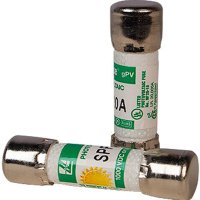

Troubleshooting ground faults is simple. Just remember to use proper safety procedures and equipment when performing these tasks. This includes locking out any disconnects and enclosures to prevent someone from mistakenly flipping breakers or reconnecting inverters.

Tools:
- Clamp meter
- Screw drivers (or 11-in-1)
- Notepad
- Pencil
- Spare GFDI fuses
Start off by inspecting the system at the inverter and ending at the array. Carefully inspect equipment and wiring for any evidence of burt or melted wire. Don’t forget your nose. You can often sniff out the problem where your eyes will not allow you to see.
Check the GFDI fuse to see if it has blown. If it is not a visual fuse, use your multimeter to test continuity. If you have a audio multimeter it will beep. If, not check the display. If the fuse is blown you should see the infinity symbol that will indicate that there is no resistance and the fuse is in-fact blown.
Next use your multi-meter (DC capable) with the current clamp to measure current at the inverter if there is enough slack in the wiring to get the clamp in and around the wiring. If there isn’t enough slack you can also measure at the disconnect or combiner if there is one. If the GFDI fuse has blown there should be no current measured at this point. If there is, this could be an indication of a double fault.
The next step is to take voltage measurements; positive to ground, negative to ground, and open circuit voltage (positive to negative). Record your measurements in your notepad.
If the fault exists and the system has multiple strings, you will want to measure at the string level to determine where the fault has occurred. The process from above is the same, just repeat for each string in the system. Record your measurements for each.
To understand what your recorded measurements are telling you is the key here. If you inspected the fuse and it had turned out to have continuity (was not blown) this does not rule out a ground fault. It could be that the fault is lower than the trip rating of the fuse.
To test that, remove the fuse and measure positive to ground and then negative to ground. If a fault is not present, both readings should be approximately half of the system’s Voc rating. Let’s assume it is not and move to the next step.
If the voltages on the positive and negative conductors are quite different this can help you to locate the string the fault has occurred and where within the string the fault has occurred.
When you isolate the strings and have taken measurement you might see something like:
Positive to Negative = 432V
Positive to Ground = 324V
Negative to Ground = 108V
Assume that the Voc of the module is 36V under normal operating conditions. A reading on the negative conductor has shown us 108V. If we divide our negative reading by 36V when get a result of 3. The fault reading indicates that the third module, counting up from the negative conductor side of the string, is where the fault has occurred.
Inspect the module for any damage. Look for cracks on the glass or cells below. Also don’t forget to check the module’s backsheet for any gouges or scratches. Check the PV wire for chaffing, severing or if the cable has been chewed on by wildlife. Likely you will spot the damage that lead to the fault. Replace the faulty module if necessary then replace the GFDI fuse. The system should now be in working order and can be brought back online.
Good luck!

Comments
How would you do this with optimizers?
Hello. Thank you for your question. It would be best for you to contact the optimizer manufacturer directly with these questions as the answer will be very much product-specific and they will know what would be best for their own DC setup. For reference, you can see this from SolarEdge here.
Thanks again.
What should the voltages be
pos to neg
pos to earth
neg to earth
The article above mentions examples of what you're looking for. Thanks again for your comment.
do we always have to only see the results of measuring the negative voltage to ground only?
or does it depend on the lowest measurement results between positive to ground (324V) and negative to ground (108V)?